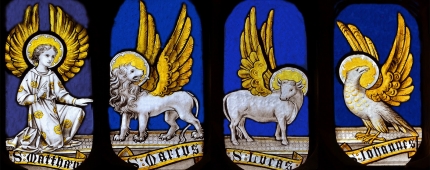While attacks by critics of the Bible as having errors in it go back to at least the third century AD, with Porphyry the Neo-Platonist, prior to the year 1860 AD, the idea that the books of the Bible were inspired, infallible, and inerrant (without error) was the prevalent view among Christians.
1610 – The Copernican Revolution begins. 1616 – The Roman Catholic Church condemned Galileo’s discovery that challenged their idea of a geo-centric universe. 1632 – Galileo ordered to appear before the Inquisition. Galileo helps popularize the view that the Bible is true in telling people on how to get to heaven (spiritual matters) but does not inform us on how the heavens go (scientific fact). [Note: Even though Martin Luther did not accept heliocentricism, many early leaders of Lutheranism (including Meltanchton and even J. Kepler) were among its biggest supporters. See Jack Repcheck Copernicus’ Secret: How the Scientific Revolution Began and Michael Keas Unbelievable: 7 Myths about the History and Future of Science and Religion.]
1620 – Novum Organum by Francis Bacon published. Set the stage for modern biblical criticism and the denial of the full authority and inerrancy of the Bible. He also drove a wedge between science and the Bible.
1650s? – Thomas Hobbes. Forerunner to Hume’s skeptical empiricism and logical positivism. Questioned miracles and supernatural. Taught that the Bible has absurdities that must be accepted by blind faith. Engaged in higher criticism of the Bible. Separated religion and science.
1670s – Benedict Spinoza publishes writings which reject the literal interpretation of the Bible, reinterpret God in a pantheistic or panentheistic sense, rejects the miraculous, and argues that the Bible contains errors and contradictions. Says the Bible contains the word of God. Spinoza’s works would become influential many decades after his death. Spinoza’s anti-supernatural rationalism laid the groundwork of modern biblical criticism in the late 1670s. From those roots the seeds of errancy spread to Richard Simon, a Priest who is often called the “Father of Biblical Criticism.” (Simon was also influenced by Louis Cappel, Johannes Morinus, and Alfonso Salmeron.)
1711 – H. B. Witter argued for two different accounts of creation between Genesis 1 and 2.
1753 – Jean Astruc posited many different writers for the book of Genesis.
1711-1776 – David Hume‘s radical empiricism increases skepticism about all things miraculous and increases the scholarly impulse to be embarrassed about anything supernatural in the Bible. [Note: some of the best critiques of Hume’s hyper-empiricism and anti-supernaturalism also come from the school of “Scottish Common Sense Realism” in the Scottish Enlightenment period. Many conservative Presbyterians (including the Old Princetonians) would side with the Scottish Realists against Hume. The liberal Presbyterians would be more influenced by Hume.]
1803 – Harvard Divinity School starts to shift from Calvinist Trinitarian to anti-Calvinist Unitarian.
1804 – Immanuel Kant dies.
1804 – Johann Eichorn – critical introduction to New Testament
1811 – “Old-Princeton Theology” (which held to its Calvinist heritage against the forces of higher criticism, modernism, and theological liberalism) began with Archibald Alexander. It would be carried on through Charles Hodge, B.B. Warfield, and John Gresham Machen.
1820 – Boston’s Congregationalists renounced Calvinism for Unitarianism
1830s – F.C. Bauer applied dialectic to Peter and Paul.
1838 – Ralph Waldo Emerson delivered a famous address to Harvard Divinity School (then a bastion of Unitarianism) and Transcendentalism made a major impact upon the school.
1859 – Charles Darwin published Origin of the Species. It’s popularity in the English-speaking world makes many English-speaking Church leaders begin to think that Genesis 1-11 contains many scientific and factual errors.
1860 – The Oxford Evolution Debate between Huxley and Wilberforce is regarded by many as the key moment in the UK (and perhaps the English-speaking world) when the majority of academics accepted the Darwinian theory of evolution. The idea that Genesis 1-11 contained errors of fact and science gained popularity.
1866 – K. H. Graf posted the basis for the JEPD theory.
1878 – The Niagara Bible Conference produced The 1878 Niagara Creed in opposition to the modernist movement. The first point of this 14-point creed was, “[We believe in] The verbal, plenary inspiration of the Scriptures in the original manuscripts” and was expounded as follows: “We believe ‘that all Scripture is given by inspiration of God,’ by which we understand the whole of the book called the Bible; nor do we take the statement in the sense in which it is sometimes foolishly said that works of human genius are inspired, but in the sense that the Holy Ghost gave the very words of the sacred writings to holy men of old; and that His Divine inspiration is not in different degrees, but extends equally and fully to all parts of these writings, historical, poetical, doctrinal and prophetical, and to the smallest word, and inflection of a word, provided such word is found in the original manuscripts.” There was probably some influence of the Old-Princetonians here.
1876 – Julius Wellhausen popularized the documentary hypothesis of the Pentateuch.
1880 – Charles Briggs introduced the idea of an inspired-but-errant Bible. He was defrocked from the general assembly of the Presbyterian Church in 1893.
1881—Hodge and Warfield wrote Inspiration.
1910-1916 – The Fundamentals published in 12 volumes in opposition to higher criticism, the modernist movement, theological liberalism, and biblical errancy. Wealthy donors fund the sending of these volumes to every pastor, missionary, and minister they could locate. The Fundamentalist-Modernist controversy intensifies.
1922 – Harry E. Fosdick gave his infamous sermon “Shall the fundamentalists win?” at First Presbyterian Church of New York. He hoped the fundamentalists would lose and the modernists would win.
1924 – Dallas Theological Seminary was established partially in response to the Fundamentalist-Modernist controversy and the fall of the mainline Protestant denominations and divinity schools to modernism/liberalism.
1925 – The Auburn Affirmation. Over 1,200 PC USA and Princeton Divinity School people petitioned against the requirement for five fundamental doctrines for Presbyterian ministers.
1925 – The Scopes Trial (or the misrepresentations by news media and a propaganda film) caused many Americans, Christian and otherwise, to believe that science and the Bible could not be reconciled. The belief that the Bible had scientific errors about human origins increased.
1929 – Westminster Theological Seminary started in response to the fall to Princeton Divinity School to modernism/liberalism. Has continuity with the “Old-Princetonian” tradition of biblical inerrancy.
1942 – The National Association of Evangelicals was established. (Arguably the start of what would become known as the Neo-Evangelical movement.)
1947 – Carl F. H. Henry publishes The Uneasy Conscience of Modern Fundamentalism, recommends directions for a new-evangelicalism to go in. Arguably becomes the father of “Neo-Evangelicalism”
1947 – Fuller Theological Seminary was established as a bastion of biblical inerrancy and Neo-Evangelical scholarship. They sought to win back the mainline Protestant Churches that had gone liberal during the modernist controversy. Founded as an apologetic institution with a strong inerrancy statement. Carl F. H. Henry (1913-2003) becomes the first Dean of Fuller Theological Seminary.
1948 – The “Neo-evangelical movement” officially began in 1948 under the leadership of conservative evangelicals like Harold Ockenga, Harold Lindsell, Carl F. H. Henry, Edward Carnell, Gleason Archer. (In the 1950s, Neo-evangelical was a positive term for conservative-wing evangelicals. In the 1980s, however, the connotative definition of neo-evangelical shifted to the progressive-wing evangelicals.)
1948 – The Evangelical Theological Society (ETS) was established. This was a major step of the Neo-Evangelical movement. Established to uphold biblical inerrancy.
1950s – Kathleen Kenyon convinced the world that the archaeological data was not reconcilable with the the Old Testament story of the destruction of Jericho and its walls. The idea that the story of the Exodus of Israel from Egypt to Canaan (through Jericho) had no archaeological support increased. The belief that the Bible contains historical and archaeological errors increased.
1955/1956 – Christianity Today. Billy Graham, Harold Lindsell, and other evangelicals launch Christianity Today on the premise of biblical inerrancy and against the popular liberal-Christian magazines like Eternity. The magazine Christianity Today was established. Another major event in the Neo-Evangelical movement. It was to be an evangelical (and inerrantist) answer to some popular liberal/modernist Protestant magazine. Originally had the leadership of Harold Lindsell and Carl F. H. Henry.
1957 – Ned B. Stonehouse (from Westminster Theological Seminary), gives the first presidential address to the ETS. The talk was titled “The Infallibility of Scripture and evangelical Progress.”
1958 – J.I. Packer published “Fundamentalism” and the Word of God. This book became a best-seller and is now a classic. It would be a big part of the reason why Packer would later become on the drafting committee of the Chicago Statements.
1962 – Harold Lindsell says it was clear in 1962 that Fuller Theological Seminary (FTS) had both professors and board members who no longer believed in the inerrancy of the Bible. Resignations began – Charles Woodbridge first, but prior to Black Saturday when the Fuller faculty and Board split over inerrancy.
1965 – Fuller Theological Seminary‘s doctrinal statement redacted. Inerrancy statement stricken form Fuller Seminary catalog. Biblical inerrancy no longer enforced for professors.
1965 – Paul Tillich dies. Tillich taught that supernatural forces cannot interfere with natural laws. A miracle is just an unusual but natural event.
1966—The Wenhem Conference on Scripture. 51 scholars from several protestant denominations. International. J.I. Packer was among them. Kenneth Kantzer too. While none of the attendees affirmed errancy, they also refused to accept inerrancy. They could not reach agreement. As a result of the conferences of the World Evangelical Fellowship, it became evident that there were two views of Scripture held by evangelicals. To discuss this issue, Ockenga convened a conference at Gordon College in June 1966, which was attended by more than fifty men from various parts of the world.
1966 – J.I. Packer published Christian Foundations, later expanded and retitled God has Spoken: Revelation and the Bible (Baker, 1979, 1993, 1994)
1966 – Gordon H. Clark delivers the presidential address to the ETS titled “The Evangelical Theological Society Tomorrow” and focuses on the Bible’s view of its self. Emphasizes that the ETS was founded on the principle that the Bible is the Word of God written, and definitely not in the Neo-Orthodox sense and, contrary to Brunner, it is the Scriptures (the writings) that are inspired.
1967—Dan Fuller’s ETS paper in Toronto defending limited inerrancy and attacking BB Warfield’s view of faith and history. Went on record as a non-inerrantist. First fuller faculty member to do so.
1967 – G.E. Ladd The New Testament and Criticism – divorces biblical authority from lack of complete inerrancy in all matters of history and criticism.
1968 – A General Introduction to the Bible published by Norman Geisler and William Nix. This became a standard textbook in many conservative seminaries and Bible schools. This established Norman Geisler’s reputation as one of the greatest conservative evangelical bibliology teachers of the day and made him one of the must-have speakers in the conferences that led up to the ICBI.
1969 – Gordon-Conwell Theological Seminary established with the help of Billy Graham and Harold John Ockenga to “establish within a strong evangelical framework, an independent, interdenominational seminary whose constituents are united in the belief that the Bible is the infallible, authoritative Word of God … consecrated to educating men and women in all facets of gospel outreach.” (Ref.)
1973 – The Conference on the Inspiration and Authority of Scripture at Ligonier, Pennsylvania. R. C. Sproul assembled a group of conservative leaders—John Frame, Peter Jones, John Gerstner, John Warwick Montgomery, J. I. Packer, Clark Pinnock—to frame “The Ligonier Statement” affirming biblical inerrancy. They presented papers and published them in an informative volume, John Warwick Montgomery, ed., God’s Inerrant Word (Bethany Fellowship, 1974). It was one of the first statements to address the rising problem of “limited inerrancy”/”partial inerrancy” among evangelicals. This was a precursor to the ICBI. (Pinnock, however, would later change camps and disown this position in his book, The Scripture Principle, [Harper & Row, 1984].) (Ref.)
1974 – Lausanne Covenant statement on the infallibility of the Bible. This left too many loopholes for infallibility to be redefined. Francis Schaeffer and Billy Graham were both disappointed with the way so many evangelicals could affirm this statement and then work against biblical infallibility. (Ref.)
1975 – Paul King Jewett (Professor at Fuller Seminary who started off conservative but then changed to Neo-Orthodox) publishes book that indicates that Paul taught errors.
1976—Harold Lindsell (conservative professor at Fuller Theological Seminary) published The Battle for the Bible. This book was a bombshell and a wake-up call to let the world know how Neo-Orthodoxy had crept into Fuller Theological Seminary and eroded its former view of the inerrancy of the Bible.
1976 – Rudolf Bultmann dies. Bultmann was a very influential scholar who taught that modern man is too advanced to accept any literal concept of miracles, miracles should be demythologized and reinterpreted existentially to grasp the truth expressed by the myth.
1976 – Jay Grimstead (who studied at Fuller under Jewett) reacted to Jewett’s conversion from conservative evangelical to neo-orthodox. He wrote to R.C. Sproul about the need for an army of scholars to create a conference that would stand for the traditional view of scripture that R.C. Sproul, John Gerstner, B.B. Warfield, and Jay Grimstead shared. This conversation led to the establishment of the ICBI in 1978.
1976—ETS confesses in minutes that some members are not signing statement in good conscience
1977 – James Barr publishes Fundamentalism as a rejoinder to conservative evangelical scholarship.
1977 – Conference on the Authority of Scripture at Mount Hermon, California. Jay Grimstead and R.C. Sproul recruited John Gerstner first (Gerstner was Sproul’s mentor), J.I. Packer second, Norman Geisler third, and Greg Bahnsen fourth. This would form the core of what would grow into the ICBI and it was here that they laid plans to establish the ICBI. Carl Henry was invited but could not make it for some reason.
1977 – Jay Grimstead wrote to Billy Graham to ask him if he’d become a member of the ICBI council. Billy declines (in favor of focusing strictly on evangelism) but provides a check for $10,000 with the provision that it be itemized as an anonymous gift and that he not be associated with the ICBI despite his keen interest in and prayers for the project. (Unpublished letters in the ICBI archives at DTS.edu.)
1977 – Carl F. H. Henry declines the invitation to be part of the advisory board of the ICBI and wonders why the project of defining inerrancy cannot be done under the aegis of the ETS rather than a new organization like the ICBI. Carl wishes Jay and the ICBI well and suggests perhaps he will have the liberty to help in the future. (Carl becomes a major contributor to and leader in the second ICBI Summit on hermeneutics.)
1977—International Council on Biblical Inerrancy (ICBI) founded (by Greg Bahnsen, John Gerstner, Norman Geisler, Jay Grimstead. Karen Hoyt, A. Wetherell Johnson, James Packer, and R.C. Sproul).
1978—ICBI Council on Biblical Inerrancy held and the “Chicago Statement on Biblical Inerrancy” (or CSBI) was signed by ~300 evangelical scholars and leaders.
1978 – Stanley N. Gundry delivers the presidential address to the ETS titled “Evangelical Theology: Where Should we be Going?” Upholds inerrancy, calls the CSBI a “remarkably balanced and comprehensive document,” and points out that there is plenty of room for debate over, and lack of consensus among inerrantists, over authorial intention, historical-critical method, literary genre, and cultural conditioning of Scripture, and hermeneutics.
1979 – Harold Lindsell publishes The Bible in the Balance (Zondervan, 1979)
1979—Jack Rogers published Authority and Interpretation of the Bible defending limited inerrancy.
1980—ICBI book titled Inerrancy published.
1982—A Critique of Roger/McKim Proposal by John Woodbridge.
1982—ICBI Council Summit #2 produces the Chicago Statement on Biblical Hermeneutics.
1982 – Ronald Youngblood requests permission from the ICBI to publish the Chicago Statement on Biblical Hermeneutics and other ICBI related material (by Carl Henry and Walter Kaiser) in the 25-th anniversary issue of the Journal of the Evangelical Theological Society and writes, “We at JETS are delighted to give the main documents of Summit II as wide a circulation as possible.”
1982 – Francis Schaeffer wrote James Boice to say that he received the Chicago Statement on Biblical Hermeneutics and said, “I have gone through it very carefully. I really am very enthused about the work that was done. I only regret that because of a clash in my schedule that I was not able to be with you in Chicago.”
1982 – Robert Gundry‘s Commentary on Matthew published by Eerdman.
1983—Robert Gundry asked to resign from ETS by nearly 74% vote.
1983—ETS minutes questions whether it is acceptable assign one’s own meaning to ETS statement.
1984—Christianity Today article on Gundry vote.
1983 – John A. T. Robinson dies. He taught that the modern world has no place for myths about miraculous contravenings of natural law.
1983 – Carl F. H. Henry completes his magnum opus God, Revelation, and Authority in six-volumes.
1984 – The Great Evangelical Disaster (Wheaton: Crossway, 1984) by Francis A. Schaeffer published. Warned that infallibility/inerrancy is a “watershed issue.” Schaeffer’s popularity and prophetic-tone helped many evangelicals in the USA begin to take this issue seriously.
1984—Inerrancy and the Church by John Hannah published by Moody.
2003? 2004? —Vote to oust Pinnock from ETS of 63% (4% short of 2/3 needed)
2003 – Norman Geisler resigned from the ETS over its resolve to enforce its stance on biblical inerrancy and over its embrace of open-theism. (Ref.)
2004 – At the 56th annual meeting of the ETS, … it became clear that very few people in the ETS were familiar with the CSBI. The CSBI was printed up and distributed to all members to reacquaint them to it.
2005 – Peter Enns (former professor of OT and hermeneutics at Westminster Theological Seminary) published Inspiration and Incarnation (Baker, 2005). Challenged the standard doctrine of inerrancy.
2006? – ETS vote of 80% to use ICBI statement as guide for meaning of Inerrancy.
2006 – The International Society of Christian Apologetics founded by Norm Geisler and the Chicago Statement on Biblical Inerrancy was included in its doctrinal statement.
2009—Michael Licona (adjunct professor at SES.edu) engages in public debate with skeptic Bart Ehrman at SES.edu and seems to say that the gospel of John contradicts the other Gospel accounts regarding the day Jesus was crucified.
2011—Norm Geisler and William Roach publish the book Defending Inerrancy.
2011—The Resurrection of Jesus: A New Historiographical Approach published by Michael Licona. He seems to recommend dehistoricizing certain narrative passages in the Gospels based on genre criticism and/or new historicism. To some this seems like he is saying Matthew’s gospel has an error of historical fact in it which we should interpret as myth/fable.
2011 – Norm Geisler approached Mike Licona privately and then publicly published his review of Mike Licona’s book. In Norm’s judgment, Licona was arguing for the same type of thing that caused the ETS to vote to expel Robert Gundry. This would turn into several open letters posted by Norm at http://normangeisler.com/licona-articles/ in critique of Licona’s views.
2011 – The court of public opinion turns against Norman Geisler. C. Michael Patton publishes Michael Licona’s Response to Norm Geisler on credohouse.org arguing that genre criticism should allow the interpreter to de-historicise Matthew 27:52-53. Several noteworthy evangelical scholars (W. David Beck, Craig Blomberg, James Chancellor, William Lane Craig, Jeremy A. Evans, Gary R. Habermas, Craig S. Keener, Douglas J. Moo, J. P. Moreland, Heath A. Thomas, Daniel B. Wallace, William Warren, Edwin M. Yamauchi) publicly sided here with Licona against Norm. This may have been a turning point, a watershed moment. Public opinion may have turned against Norm. Several prominent members of the ETS were clearly ignorant of or apathetic to the affirmations and denials in the Chicago Statement on Biblical Inerrancy (which ETS members are supposed to affirm) and the Chicago Statement on Biblical Hermeneutics. Interestingly, Habermas, Moreland, and Yamauchi had been among the original signers of CSBI in 1978.
2013 – BastionBooks.com founded by Norm Geisler as an e-book publishing company as a bastion of biblical inerrancy. In 2013, BastionBooks.com publishes Explaining Biblical Inerrancy to make the ICBI statements and their official ICBI commentaries available to the public in digital format. Bastion Books also republishes other books on the inerrancy debate by Norm.
2014 – DefendingInerrancy.com web site started by Norm Geisler (and others). Several prominent evangelical leaders to consider signing the ICBI-inspired “Bible Petition.” It quickly got 40,000 signatories.
2016 – Vital Issues in the Inerrancy Debate (Wipf&Stock, 2016) published by “the Defending Inerrancy team.” This book was mostly a collection fo some of the best blogs/articles posted on defendinginerrancy.com.
2017 – Why Are There Differences in the Gospels? What We Can Learn From Ancient Biography (Oxford University Press, 2017) published by Michael Licona. After a debate with skeptic Bart Ehrman in which alleged contradictions in the New Testament seemed like they needed a new apologetic response, Licona began to devote himself to finding solutions to this problem. He began lecturing on differences/contradictions in the gospels and would eventually publish his book. Reviews with constructive criticism were made by inerrantists Norm Geisler, F. David Farnell, Doug Potter and by biblical maximalist Lydia McGrew. Interestingly, J.P. Moreland, who had earlier sided with Licona against Geisler on the issue of hermeneutics overriding inerrancy in 2011, began to side with Lydia McGrew against Licona on the same type of issues in 2016.
2018 – Moody Bible College removes some professors who are staunch inerrantists, embrace one professor who is not an inerrantist, and adopts the shorter statement of the CSBI as their extension of their doctrinal statement.
2018 – The “conservative resurgence” of the Southern Baptist Convention ends and the progressive/liberal takeover of the SBC seminaries begins.
2019 – Richard Howe and Mike Licona have a public dialogue/debate over the definition of biblical inerrancy. Mike Licona seeks to redefine biblical inspiration that is novel to traditional evangelicalism.
2020 – Lydia McGrew’s book The Mirror or the Mask, her blogs, and her vlogs elicit a response from Mike Licona.
2020 – As of July 23rd, 2020, defendinginerrancy.com’s Bible Petition has 69,591 signatures. 87 signatures added in the last thirty days. It had over 415,000 visits in the last year.
Partial list of sources:
Some unpublished materials from the ICBI archives held at the library of Dallas Theological Seminary
Geisler, Norman. A History of Western Philosophy, Volume II: Modern and Postmodern: From Descartes to Derrida. (Bastion Books, 2016)
Geisler, Norman. Biblical Errancy: An Analysis of its Philosophical Roots, third edition (Bastion Books, 2013)
Lindsell, Harold. The Battle for the Bible.
Bruce Kuklick’s Churchmen and Philosophers: From Jonathan Edwards to John Dewey
C. Gregg Singer’s A Theological Interpretation of American History
Hannah, John. An Uncommon Union
Grimstead, Jay. Rebuilding Civilization on the Bible. Contains several notes by Jay, the original visionary for the ICBI, on the ICBI.
Sexton, Jason. “How Far Beyond Chicago? Assessing Recent Attempts to Reframe the Inerrancy Debate.” Themelios, Volume 34 – Issue 1.
Sandeen, Ernest Roots of Fundamentalism.
Quo Vadis Evangelicalism? edited by Andreas Kostenberger. Nine addresses from ETS presidents in the first fifty years of the ETS/JETS. (Crossway, 2007)














